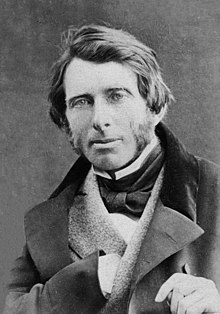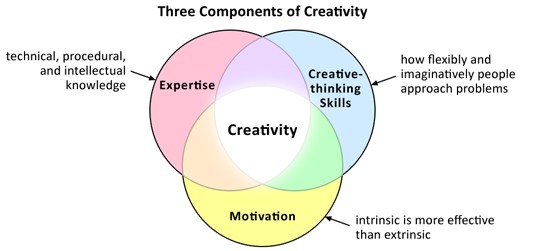John Ruskin Elements of Drawing 1857 - the search for the origins of the modern elements and principles of art
As I said in my last post I am trying to find the earliest example of the elements and principles of art. I want to know who authored them and why and how they evolved into what they are.
My first book I am reviewing in this quest (yes, I just went there) is John Ruskin's Elements of Drawing.
John Ruskin is an English Victorian art critic. His fame started with his published work Modern Painters in 1843 in which he defends the artist Turner.


This book is really three separate letters that were written to the beginning drawing student. He actually says the book and it's exercises are not for children under the age of 12-14. The first two letters are for improving drawing landscapes from life. They are filled with exercises with perception as the main focus, but always with nature in mind. Along with drawing trees, he has lessons on drawing shades in drapery and dead white porcelain objects. In the first letters he seems fixated on shade over line, often mentioning the great artists of chiaroscuro. Along with shading he talks about drawing delicately. A term that he interprets a few times in different contexts but to me always seemed to fall back on not rushing or trying to be bold.
These are some great quotes from these first two letters:
"There is no merit in doing wrong easily."
"Nearly all expression of form, in drawing, depends on your power of gradating delicately."
"For nature is made up of roundnesses., not the roundness of perfect globes, but of various curved surfaces."
"Everything you can see in Nature is seen only so far as it is lighter or darker than the things about it, or of a different color of them."
The last letter is the meaty one in so far as the elements and principles go. He starts off the letter on the use of colour, always apologizing about how he can't have color examples in the book. There are some great tips in there as well.
Then he goes into composition. As he puts it, "Composition means, literally and simply, putting several things together, so as to make one thing out of them; the nature of goodness of which they all have a share in producing."
He also, however, adds "It is impossible to give rules which enable you to compose. You might more easily receive rules to enable you to be witty." & "The essence of composition has precisely in the fact of its being unteachable."
Of course he then lays out his 8 laws of composition!
1. Principality: "One feature shall be more important than the rest, and the others shall group with it in subordinate positions." So quite simply, have a focal point that the other elements support
2. Repetition: Echoing a feature to create unity,
3. Continuity: (I love this one) "Giving some orderly succession to a number of objects more or less similar." His examples are: Columns going off into perspective, and clouds fading into the distance getting both softer and smaller. He adds "If there is no change at all in the shape or size of objects; there is no continuity; there is only repetition - monotony.
4. Curvature: "All beautiful objects are terminated by delicately curved lines, except when needs for stability." He refers to curvature in both individual objects, like in the quote, as well as objects in a composition ending or lining up in a curve.
5. Radiation: Things radiating out from a point. Often with the point far off the page. "Enforcing unison of action in arising form, or proceeding to, some given point, the most influential in producing the beauty of groups of form."
6. Contrast: Composing two things of opposition next to each other be it line, color, value. "Rest can only be enjoyed after labour; light is exhibited by darkness."
7. Interchange: The UNITY of opposite things. This refers not to things that are opposite lying next to each other, but uniting two objects by interchanging a characteristic. For example adding the tint of a dominant item into the other subordinate item.
8. Harmony: "if you change one thing in the system of nature - you must change them all to match the new system." He talks about this with an eye to nature or painting what you see. If you are painting a landscape and make one color in it more saturated than what you see in life, then you have to add saturation to the whole composition.
His laws of composition are not too different than our principles of art:
Ruskin's list is just so good, I wonder if he is borrowing from someone else that I haven't found yet. If you know of any such list let me know. He does mention Samuel Prout's book: Hints on Light and Shadow, Composition &c. so I did read that as well. It is a much shorter text that mainly revolves around him giving what I would call tips along with beautiful visual plates. Things like: triangular compositions are pleasing, use the 2/3, 3/5, or 4/9 rule of light and dark, and avoid equal quantities of contrast. Although he is an amazing artist and has some great tips there is nothing that resembles a list of any sort.
Ruskin's list is so perfect it makes me hope it is the first of it's kind and the one that others drew upon. He is such an enjoyable writer, and so impassioned about what he talks about I highly recommend you reading it yourself. One thing that I learned is, that if he is the first, he did not write the laws expecting to use them to create a good composition. More that the laws are evident in good work. Also he is mostly focusing on landscapes and creating and finding good compositions in Nature.
here is the link to this book on google books:
http://bit.ly/1FbVWhd
or on Amazon if you wish a hard copy:
http://www.amazon.com/The-Elements-Drawing-John-Ruskin/dp/1453842640



